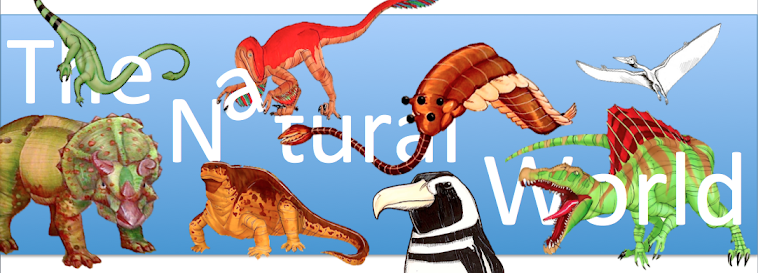Welcome to Round 1 of our Trivia Contest of Winter 2013! Below we have the questions that make up Round 1. I discussed the rules in our last post, which you can read by clicking HERE. Each question is worth 2 points, unless otherwise indicated. Below the actual questions, I will include an answer sheet. You can copy and paste the answer sheet into an email or a Word document, and email them to me at tnaturalworld1@gmail.com. In your email, please also include your team name and the names of your team members. All answers for Round 1 must be received by Saturday December 28th! Here are the questions. Good luck!
1. Which of the following is NOT an archosaur?
A. American Alligator
B. Tyrannosaurus rex
C. Pteranodon
D. Komodo dragon
E. Stegosaurus
2. Though
they are called the “Buffaloes,” what is really the mascot of the University of
Colorado in Boulder?
3. In terms of their names, name the odd one out:
A.
Dracorex
B.
Guanlong
C.
Triceratops
D. Hippodraco
4. What dinosaur is pictured here? (1 point for a relatively close answer, 2 points for the correct answer.)
5. Is Megalodon still alive today? Should we trust Discovery Channel?
6. Which of the following birds is made up?
A.
Hammerkop
B.
Screwdriver-bill
C.
Helmeted Hornbill
D. Shoe-bill
E. Spoon-bill
7. Which of the following species of snake is most
closely related to the milk snake, Lampropeltis
triangulatum?
A.
Corn Snake
B.
Anaconda
C.
Rattlesnake
D.
Kingsnake
E. Pit Viper
8. Which of the following is NOT a textbook case of
convergent evolution:
A.
Thylacosmilus/Smilodon
B.
Musk Deer/Chinese Water Deer
C.
Mammoth/Mastodon
D. Gray Wolf/Thylacine
9. What in the world is THAT! (1 point for a relatively close answer, 2 points for the correct answer.)
10. For almost every single constellation that we recognize here on Earth, the stars that make up that constellation almost always have no physical relationship with each other, and just appear to be close together from here on Earth. Name the one major exception, known to the Japanese as “Subaru.”
11. What shape is wombat poop?
12. True or False: On average, hyenas scavenge more
than lions.
13. Some people think that the discovery of
fossilized Protoceratops bones in the
Gobi Desert was the inspiration behind what mythical creature?
A.
Dragon
B.
Griffin
C.
Mermaid
D. Cyclops
E. Centaur
14. What’s wrong with this story: “As the giant man
used his pocketknife to help him circumnavigate the great jungles of the Amazon
Basin, he was startled by the abundant diversity of life. He saw everything from piranha, macaws, and
anaconda, and even saw a black leopard attack a javelina!”
15. Dermal armor is a feature seen by all of the
following except:
A.
Giant ground sloths
B.
Armadillos
C.
Pangolins
D.
Glyptodonts
E.
Ankylosaurs
F. Clouded leopard
16. All of the following dinosaurs have been
discovered in the Morrison Formation, which has outcrops in Colorado, Wyoming,
Utah, and several other states. All,
that is, except for which one?
A.
Utahraptor
B.
Apatosaurus
C.
Stegosaurus
D.
Camptosaurus
E.
Allosaurus
F. Gargoyleosaurus
17. What is pictured here?
A.
Mosasaur
B.
Dinosaur
C.
Pterosaur
D.
Ichthyosaur
E.
Plesiosaur
F. Dolphin
18. What strange feature seen in the young hoatzin
sets it apart from any other living birds, and forges a resemblance with its
extinct ancestors like Archaeopteryx?
A.
Tentacles
B.
Claws on wings
C.
Teeth in mouth
D. Marshmallows
E. Flightlessness
19. How many species of penguin live and breed in
the Northern Hemisphere, above the Equator?
A.
Two, the African and Galápagos Penguin
B.
None, everyone knows penguins live at the South
Pole
C.
None, everyone knows penguins live at the North
Pole
D.
One, the African Penguin
E.
None, everyone knows penguins live in Antarctica
F.
One, the Galápagos Penguin
G. None, penguins don’t exist
20. What Triassic animal is pictured here, courtesy
of Sam Lippincott? (1 point for a relatively close answer, 2 points for the correct answer.)
 |
| Photo Credit: Sam Lippincott |
21. Why is it ironic when people kill bull snakes,
mistaking them for rattlesnakes?
A.
Because bull snakes ARE rattlesnakes
B.
Because bull snakes kill and eat rattlesnakes
C.
Because bull snakes are more venomous than
rattlesnakes
D. Because rattlesnakes and bull snakes live on
different continents
E. Because bull snakes don’t exist
22. A blast from the past: having been around for
hundreds of millions of years, what is the name of this “living fossil?” (1 point for a relatively close answer, 2 points for the correct answer.)
23. Which of the following is a habitat that you
would NOT expect to find a kangaroo in?
A.
The Australian Outback
B.
In the forest canopy of New Guinea rainforests,
60 feet above the ground
C.
Swimming in the shallows of the Great Barrier
Reef, consuming kelp and other oceanic plants
D.
The Australia Zoo
E. Oh, kangaroos definitely exist, I would just
expect to find them in all of these locations.
After all, they ARE kangaroos.
24. Which of the following is NOT a term used in
reference to a past mass extinction?
A.
K/T Event
B.
Cambrian Explosion
C.
The Great Dying
D. Deccan Traps
25. Scientific names too hard to remember? That’s not the case for this “river horse.”
Now, here is the answer sheet. It really is not that complicated, just copy and paste this into an email and send it my way at tnaturalworld1@gmail.com!
1.
2.
3.
4.
5.
6.
7.
8.
9.
10.
11.
12.
13.
14.
15.
16.
17.
18.
19.
20.
21.
22.
23.
24.
25.

